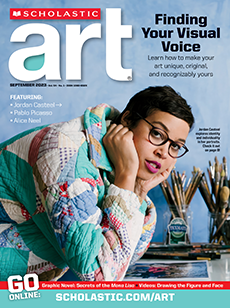Study the sculpture above. When do you think it was made? Maybe you guessed that it’s a work of modern art because of its clean, geometric shapes. But someone actually crafted this figure thousands of years ago. People have been representing the human figure in art since before recorded history. Over time, tastes have varied, the methods people use to make art have changed, and the ideas artists explore have differed a lot. The articles in this issue won’t introduce every artistic style in history, but they will give you a taste of how and why artists’ interpretations of the figure have varied wildly over time.
Study the sculpture above. When do you think this figure was made? Its clean geometric shapes look modern. But someone carved it many years ago. People have represented the human figure in art since prehistoric times. But the ways they do that have changed a lot over the years.
